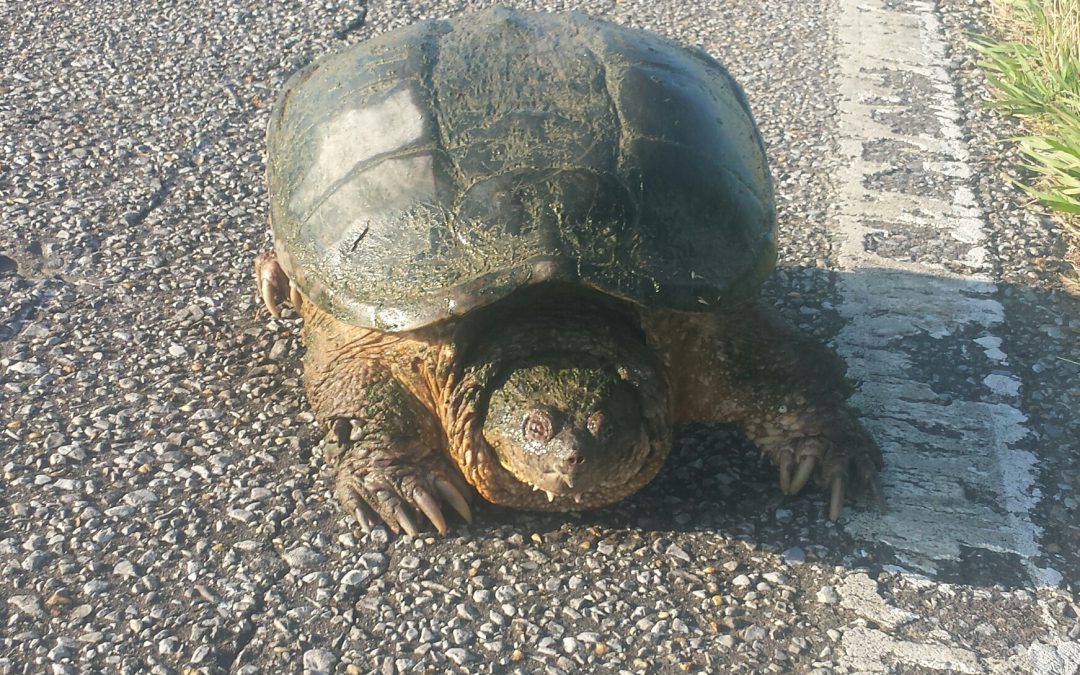
by Rick O'Connor | Jan 21, 2020
There are a couple of things you learn when working with youth in turtle education.
1) ALL turtles are snapping turtles
2) Snapping turtles are dangerous
I grew up in a sand hill area of Pensacola and we found box turtles all of the time. We had one as a “pet” and his name was “Snappy”. Oh, I forgot… all turtles are males.
That said, others are well aware of this unique species of turtle in our state. It does not look like your typical turtle. (1) They are large… can be very large – some male alligator snappers have weighed in at 165 lbs.! (2) Their plastron is greatly reduced, almost not there. Because of this their legs can bend closer to the ground and walk more like dogs than other turtles do. We call this cursorial locomotion. Snappers are not cursorial, but they are close, and because of this can move much faster across land. (3) Their carapace is almost square shaped (versus round or oval) and have large ridges making them look like dinosaurs. (4) They have longer tails than most turtles, some species have scales pointing vertically making them look even more like dinosaurs. Scientists have wondered whether this unique reduced plastron-better locomotion design was the original for turtles (and they lost it), or they are the “new kids on the block”. The evidence right now suggests they are “the new kids”.
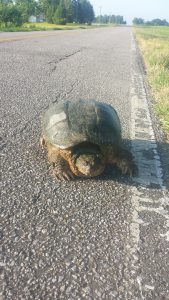
The relatively smooth shell of a common snapping turtle crossing a highway in NW Florida.
Photo: Libbie Johnson
And of course, there is the “SNAP”. These are very strong animals who seem to crouch and lunge as they quickly SNAP at potential predators – as quickly as 78 milliseconds/bite. I remember once stopping on a rural highway to get one out of the road. I grabbed it safely behind the nape and near the rear. That sucker crouched and snapped, and I could hardly hold on. I was amazed by its strength. It did not understand I was trying to help. You do need to be careful around these guys.
In Florida, we have two species of snapping turtles; the common and the alligator. They look very similar and are often confused (everyone seen is called an alligator snapper). There are couple of ways to tell them apart.
1) The alligator snapper has a large head with a hooked beak.
2) The alligator snapper’s carapace is slightly squarer and has three ridges of enlarged scales that make it look “spiked”; where the common snapper lacks these.
3) The tail of the common snapper has vertical “spiked” scales; which the alligator lacks.
4) And the textbook range of the alligator snapper is the Florida panhandle. Basically, if you are south or east of the Suwannee River, it should not be around – you are seeing the common.
As the name implies, the common snapper (Chelydra serpentina) is found throughout the state – except the Florida Keys. There are actually two subspecies; the Common (C. serpentia serpentina) which is found west of the Suwannee River and the Florida Snapper (C. serpentina osceola). This species uses a wide range of habitats. They have been found in small creeks, ponds, floodplain swamps, wet areas of pine flatwoods, and on golf courses.
These are very mobile turtles, often seen crossing highways looking for nesting locations, dispersing to new territory, or their pond has just dried up and they need a new one. Interestingly they have an expanded diet. Most think of snapping turtles as fish eaters, but common snappers are known to consume large amounts of aquatic plants and invertebrates.
Like all turtles, snappers must find high-dry ground for nesting. Nesting begins around April and runs through June. In south Florida, nesting can begin as early as February. They select a variety of habitats and typically lay 2-30 eggs deep in the substrate. These incubate for about 75 days and the temperature of the egg determines its sex; warmer eggs produce females. Nest predation is a problem for all turtles, snappers are not exempt from this. Raccoons are the big problem, but fish crows, fox, and possibly armadillos also dig up eggs. Many adults have been found with leeches. Turtles are known to live long lives. Data suggests common snappers reach 50 years of age.
Alligator snappers (Macrochelys temminckii) are the big boys of this group. Where the common snapper’s carapace can reach 1.5 feet, the alligator snapper can reach 2.0. (that’s JUST the shell). As mentioned, this animal is found in the Florida panhandle only. It is a river dweller and prefers those with access to the Gulf of Mexico. They appear to have some tolerance of brackish water. One alligator snapper near Mobile Bay AL had barnacles growing on it. Evidence suggest they do not move as much as common snappers and stay in the river systems where they were born. There are three distinct genetic groups: (1) the Suwannee group, (2) the Ochlocknee/Apalachicola/Choctawhatchee group, and (3) the Pensacola Bay group.
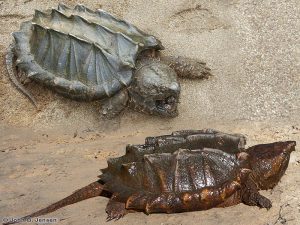
The ridged backs of the alligator snapping turtle. Photo: University of Florida
This animal is more nocturnal than their cousin and are not seen very often. They are basically carnivores and known to feed on fish, invertebrates, amphibians, birds, small mammals, reptiles, small alligators, and acorns are common in their guts. This species possesses a long tongue which they use as a fishing lure to attract prey.
Alligator snappers have a much shorter nesting season than most turtles; April to May. And, unlike other turtles, only lay one clutch of eggs per season. They typically lay between 17-52 eggs, sex determination is also controlled by the temperature of the incubating egg, and they may have strong site fidelity with nesting. Male alligators are very aggressive towards each other in captivity. This suggests strong territorial disputes occur in the wild. These live a bit longer than common snappers; reaching an age of 80 years.
Though still common, both species have seen declines in their populations in recent years. Dredge and fill projects have reduced habitat for the common snapper. Dams within the rivers and commercial harvest have impacted alligator snapper numbers. The alligator snapper is currently listed as an imperiled species in Florida and is a no-take animal (including eggs). Because the common snapper looks so similar, they are listed as a no-take species as well.
Both of these “dinosaur” looking creatures are amazing and we are lucky to have them in our backyards.
References
Meylan P.A. (Ed). 2006. Biology and Conservation of Florida Turtles. Chelonian Research Monographs No.3, 376 pp.
FWC – Freshwater Turtles
https://myfwc.com/wildlifehabitats/wildlife/freshwater-turtles/.
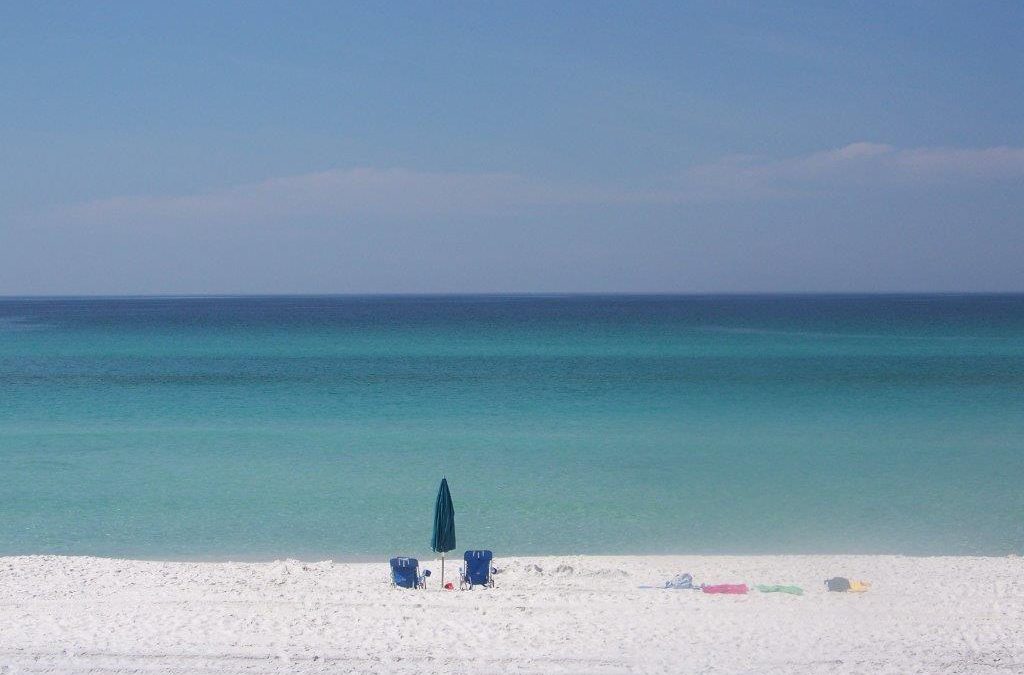
by Rick O'Connor | Jan 14, 2020
Standing on one of our local beaches, the Gulf of Mexico appears to be a wide expanse of emerald green and cobalt blue waters. We can see the ripples of offshore waves, birds soaring over, and occasionally dolphins breaking the surface. But few of us know, or think, about the environment beneath the waves where 99% of the Gulf lies. We might dream about catching some of the large fish, or taking a cruise, but not about the geology of the bottom, what the water is doing beneath the waves, or what other creatures might live there.
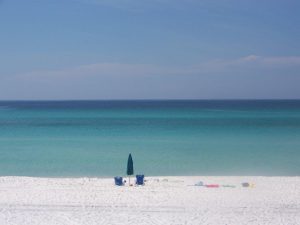
The Gulf of Mexico as seen from Pensacola Beach.
Photo: Molly O’Connor
Scanning the horizon from the beach, you are gazing at 600,000 square miles of open water. It is about 950 miles from the panhandle to Mexico. Traveling at 10 knots, it would take you about 3 days to cross at its widest point. The Gulf is almost an enclosed body of water. The bottom is somewhat “bowl” shaped with the deepest portion slightly west of center at a location known as the Sigsbee Deep. The island of Cuba serves as the “median” between where the ocean enters and exits the Gulf. Cycling water from the Atlantic crosses from Africa, through the Caribbean, and enters the between Cuba and the Yucatan. The seafloor here sinks and spills into the Sigsbee Deep. The pass between Cuba and Yucatan is about 6500 feet deep and the bottom of the Sigsbee Deep is about 12,000. If you are looking due south from the Florida Panhandle, you would be looking at this pass.
If your gaze shifted slightly to the right – maybe “1:00” – you would be looking at the Yucatan. The Yucatan itself forms a peninsula and a portion of it is below sea level extending further into the Gulf. This submerged portion of the Yucatan is what oceanographers refer to as a continental shelf. On the “leeward” side of the Yucatan Peninsula lies an area of the Gulf known as the Bay of Campeche. There is a shallow section of this “bay” known as the Campeche Banks which supports amazing fisheries and some mineral extraction. Off the Yucatan shelf there is a current of water that rises from the ocean floor called an upwelling. These upwellings are usually cold water, high in oxygen, and high in nutrients – producing an area of high biological productivity and good fishing.
Continuing to circle the Sigsbee Deep and looking about “2:00”, northwest of the Bay of Campeche, you enter the western Gulf which extends from Vera Cruz Mexico to the Rio Grande River in Texas. The shelf is much closer to shore here and the marine environment is still tropical. There is a steep continental slope that drops into the Sigsbee Deep. Water from the incoming ocean currents usually do not reach these shores, rather they loop back north and east forming the Loop Current. The shelf extends a little seaward where the Rio Grande discharges, leaving a large amount of sediment. In recent years, due to human activities further north, water volume discharge here has decreased.
In the direction of about “2:30”, is the Northwestern Gulf. It begins about the Rio Grande and extends to the Mississippi Delta. Here the continental shelf once again extends far out to sea. One of the larger natural coral reefs in the Gulf system is located here; the Flower Gardens. This reef is about 130 miles off the coast of Texas. The cap is at 55 feet and drops to a depth of 160 feet. Because of the travel distance, and diving depth, few visit this place. Fishing does occur here but is regulated. This shelf is famous for billfishing, shrimping, and fossil fuel extraction. The Mississippi River, 15th largest in the world and the largest in the Gulf, discharges over 590,000 ft3 of water per second. The sediments of this river create the massive marshes and bayous of the Louisiana-Mississippi delta region, which has been referred to as the “birds’ foot” extending into the Gulf. This river also brings a lot of solid and liquid waste from a large portion of the United States and is home to one of the most interesting human cultures in the United States. There is much to discuss and learn about from this portion of the Gulf over this series of articles.
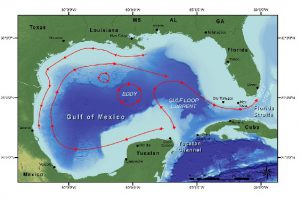
The basin of the Gulf of Mexico showing surface currents.
Image: NOAA
At this point we have almost completely encircled the Sigsbee Deep and move into the eastern Gulf. Things do change here. From the Mississippi delta to Apalachee Bay west of Apalachicola is what is known as the Northeastern Gulf – also known as the northern Gulf – locally called the Gulf coast. This is home to the Florida panhandle and some of the whitest beaches you find anywhere. Offshore the shelf makes a “dip” close to the beach near Pensacola forming a canyon known as the Desoto Canyon. The bottom is a mix of hardbottom and quartz sand. Near the canyon is good fishing and this area, along with the Bay of Campeche, is historically known for its snapper populations. It lies a little north of the Loop Current but is exposed to back eddies from it. Today there is an artificial reef program here and some natural gas platforms off Alabama.
Looking between “9:00-10:00” you are looking at the west coast of Florida and the Florida shelf. Here the shelf extends for almost 200 miles offshore. Off the Big Bend the water is shallow for miles supporting large meadows of seagrass and a completely different kind of biology. The rock is more limestone and the water clearer. In southwest Florida the grassflats support a popular fisheries area and a coral system known as the Florida Middle Grounds. At the edge of the shelf is a steep drop off called the Florida Escarpment, which forms the eastern side of the “bowl”. Another ocean upwelling occurs here.
Looking at “11:00” you are looking towards the Florida Keys. Between the Keys and Cuba is the exit point of the Loop Current called the Florida Straits. It is not as deep as here as it is between Cuba and the Yucatan; only reaching a depth of 2600 feet. This is mostly coral limestone and the base of one of the largest coral reef tracks in the western Atlantic. The coral and sponge reefs, along with the coastal mangroves, forms one of the more biological productive and diverse regions in our area. It supports commercial fishing and tourism.

We did not really talk about the bottom of the “bowl”. Here you find remnants of tectonic activity. Volcanos are not found but you do find cold and hot water vent communities, which look like chimneys pumping tremendous amounts of thermal water from deep in the Earths crust. These vent communities support a neat group of animals that we are just now learning about. Brine lakes have also been discovered. These are depressions in the seafloor where VERY salty water settles. These “lakes” have water much denser than the surrounding seawater and can even create their own waves. Many of them lie as deep as 3300 feet and can be 10 feet deep themselves. There is one known as the “Jacuzzi of Despair”. They are so salty they cannot support much life.
In the next addition to this series we will begin to look at the some of the interesting plant and animals that call the Gulf home.
Embrace the Gulf.
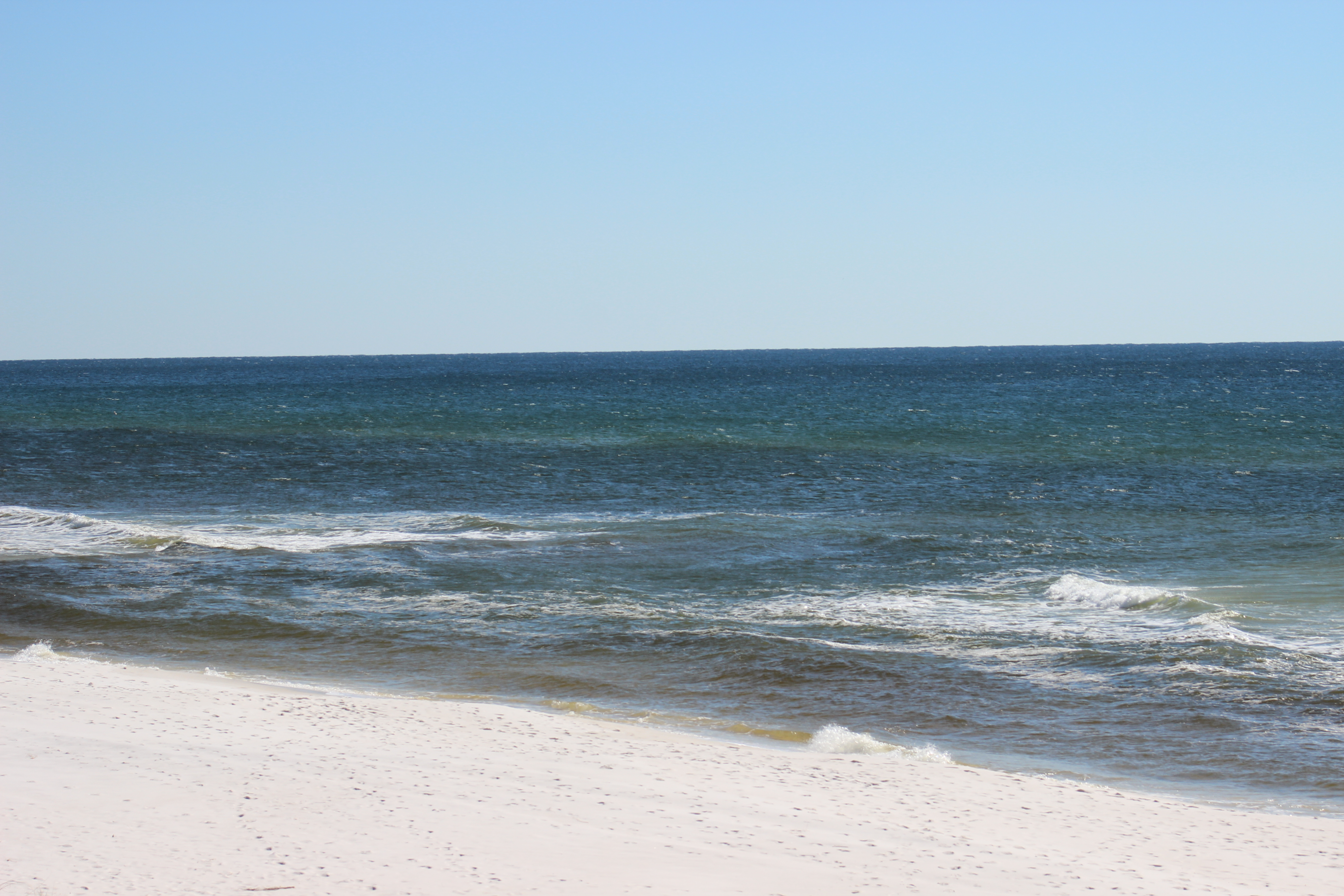
by Rick O'Connor | Jan 10, 2020
It’s an amazing place really – the Gulf of Mexico. Covering over 598,000 square miles this almost a complete circle of water and home to some interesting geological features, amazing marine organisms, some of busiest ports in the United States, offshore mineral extraction, great vacation locations, and amazing local culture.
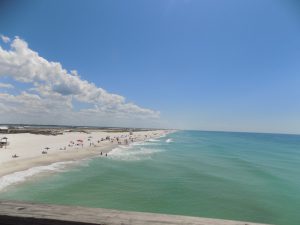
View from the Navarre Beach pier Photo credit: Lydia Weaver
As you stand along Pensacola Beach and look south, you see a wide expanse of water that seems to go on forever. However, in oceanographic terms, the Gulf is not that large of a body of water. Though it is close to 600,000 square miles in size, the Atlantic Ocean is 41,000,000 and the Pacific is 64,000,000 square miles. In addition to area, the mean depth of the Atlantic is a little over 12,000 feet and the Pacific is 14,000 feet. In comparison, the deepest point of the Gulf is 14,000 feet and the mean depth is only 5,000. The shape of the bottom is like a ceramic bowl that was not centered well when fired. The deepest point, the Sigsbee Deep, is about 550 miles southwest (about “2:00” if you are looking from the beach). The shape appears like a hole made by a golf ball that landed in a sand trap. As a matter of fact, there are scientists who believe this is exactly what happened – a large asteroid or comet made have hit the Earth near the Gulf forming a large series of tsunamis and created the Gulf as we know it today.
Either way the “pond” (as some oceanographers refer to it) is an amazing place. The bottom is littered with hot vents, brine lakes, and deep-sea canyons. Large areas of the continental shelf support coral reef formation and a great variety of marine life. Some of the busiest ports in the United States are located along its shores, and it supplies 14% of the wild domestic harvested seafood. Everyone is aware of the mineral resources supplied on the western shelf of the Gulf and the tremendous tourism all states and nations that bordering enjoy.
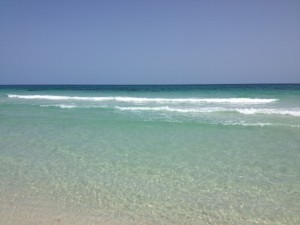
The emerald waters of the Gulf of Mexico along the panhandle.
This year the Gulf of Mexico Alliance will be celebrating “Embracing the Gulf” with a variety of activities and programs across the northern Gulf region. We will be dedicating this column to articles about the Gulf of Mexico all year and discussing some of the topics mentioned above in more detail. We hope you enjoy your time here and get a chance to explore the Gulf’s seafood, fishing, diving, marine life, ship cruises, unique cultures, and awesome sunsets. Embrace the Gulf!
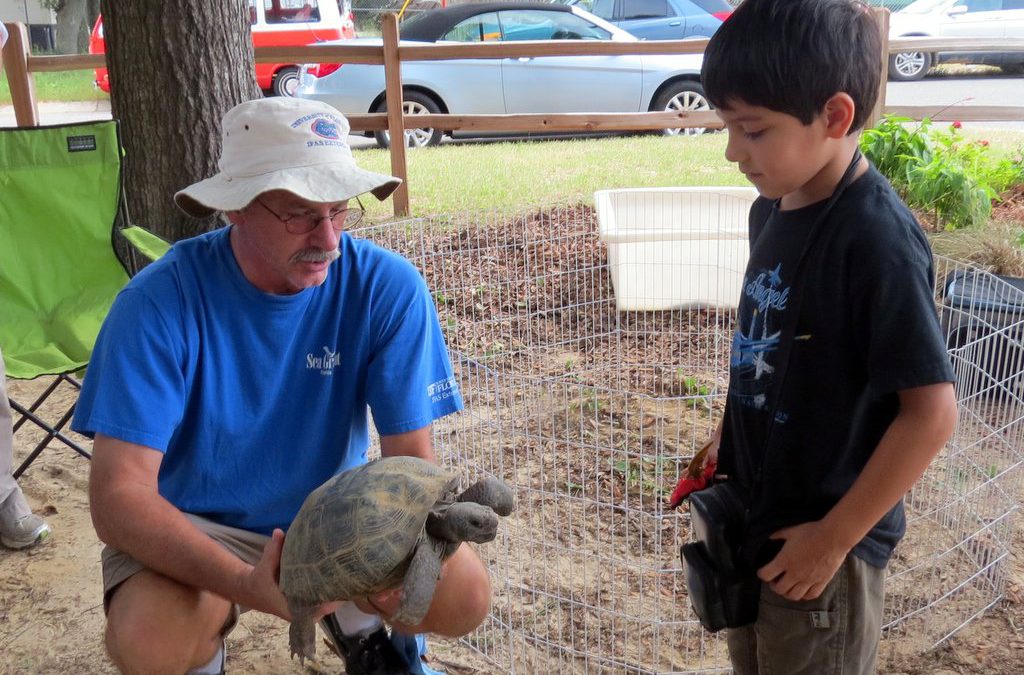
by Rick O'Connor | Jan 8, 2020
How cool, there is nothing wrong with other animals, but how cool for a year to be dedicated to turtles. And how fitting for the Florida panhandle. Based on the publication Biology and Conservation of Florida Turtles (2006), there are 38 taxa of turtles in our state. The majority of these can be found in the panhandle, particularly near the Apalachicola and Escambia Rivers. Within our state some species are only found at these two locations, and some are only found there on the planet.
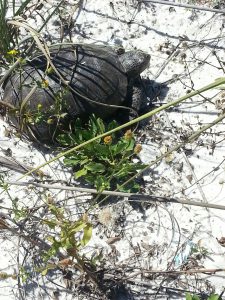
A terrestrial gopher tortoise crossing the sand on Pensacola Beach.
Photo: DJ Zemenick
Everyone loves turtles.
I hear a lot of stories about families trying to rescue while they are crossing highways. And when it comes to conservation, most will tell you “don’t mess with the turtles”. They are not kola bears… but they’re close. So, we are excited that 2020 is not only the year to Embrace the Gulf of Mexico, but also the Year of Turtle, and we plan to post one article a month highlighting the species richness of our area.
Let’s start with turtles in general.
Most know they are vertebrates but may not know the backbone and ribs support the framework for their famous shell. The top portion of this shell, where the backbone is, is called the carapace. The hard portion covering their chest area is the plastron. And they are connected by the bridge. The shell is a series of bony plates covered with scales (scutes). These scales are what put them in the class Reptilia. Fish also have scales but differ from reptiles in that they have gills instead of lungs. Most turtles are excellent swimmers, but they must hold their breath underwater, and some can do this for quite a long time.
All turtles are in the same Order Chelonia. The terms tortoise and terrapin are more cultural than biological. There are 7 families, and 25 species, of turtles found in Florida. Some are marine, and some terrestrial, but most are what we call “riverine”, living in freshwater.
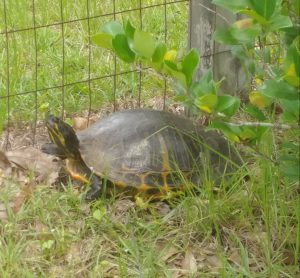
This aquatic Florida Cooter was found crossing a locals yard.
Photo: Deb Mozert
Turtles lack teeth but do have a blade like beak they can cut with. In general, smooth blades are carnivorous, serrated ones herbivorous, and their omnivorous turtles as well. Most prey are small, and most carnivores must conceal themselves to ambush their prey. Though depicted as slow animals in fairy tales and stories, turtles can be quite fast for a few seconds.
Most are diurnal (active during daylight hours) but some nocturnal activity does occur. They spend parts of their day basking on logs and other platforms to warm – turtles are ectothermic and rely on the sun for heat.
Mating occurs in the spring. And despite the fact that most are aquatic, nesting occurs on land for all. Except for a few live bearers, reptiles lay cledoic eggs (shelled) buried on dry ground. Sex is determined by the temperature of the egg in all except the softshell turtles, with eggs at 30° C or higher producing females.
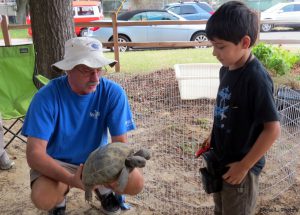
Teaching our youth about the great diversity of Florida’s turtles.
Photo: Molly O’Connor
Despite their need for warm climates, they can be found throughout the United States. But it is the warm humid southeast where they thrive. Especially the northern Gulf Coast where 60″ of rainfall each year is the norm. We will bring you an article about a new species every other week throughout this year.
Let’s Celebrate the Year if the Turtle.
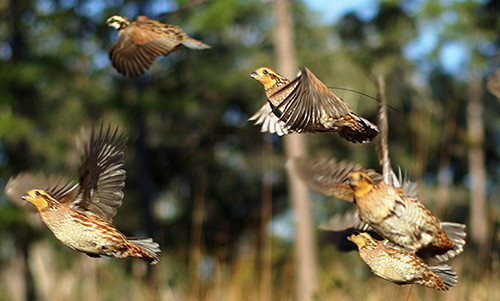
by Rick O'Connor | Dec 13, 2019
‘Bobwhites in Pine Savanna’ Workshop Set
For Jan. 30 in Marianna, Florida
The National Bobwhite Conservation Initiative (NBCI) and partners will host the Tri-State Bobwhite Symposium for professional land managers and landowners Thursday, January 30, 2020, in Marianna, FL.
It is the second Working Lands for Wildlife–Bobwhites in Pine Savanna workshop funded by the Natural Resources Conservation Service and is expected to draw attendees from three states. The program goal is to restore pine savanna on 82,000 acres across seven states using thinning, prescribed fire, and native grass restoration. Federal funding is available to landowners who choose to pursue pine savanna management on that designated landscape.
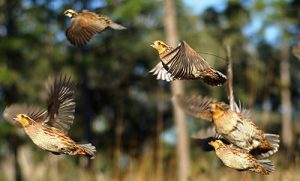
Bobwhite quail are popular with many hunters and management is trying to restore them.
Photo: USDA
“Private lands are a critical and necessary component for landscape-scale restoration of wild bobwhites, which is what NBCI is all about,” said NBCI Forestry Coordinator Steve Chapman. “Active management of pine forests on those lands, while still meeting landowner objectives, is a key NBCI strategy, and 82,000 managed acres will show the dividends of this approach.”
Dr. Jess McGuire, Quail Forever’s Working Lands for Wildlife bobwhite coordinator, added that “in order to achieve this level of restoration, wildlife professionals must be trained in the nuances of bobwhite management.”
The workshop will be from 9am–2pm at the University of Florida, Institute of Food and Agricultural Sciences (UF/IFAS) office, located at 2741 Penn Avenue, Suite 3, Marianna, FL 32448. Preregistration by January 23 is required by contacting jmcguire@quailforever.org or online at http://bit.ly/tristatequail.
Additional partners include Quail Forever, Florida Fish and Wildlife Conservation Commission, Tall Timbers Research Station and Land Conservancy, University of Florida Extension, and the Natural Resources Conservation Service.
Through multiple agreements, NBCI, in collaboration with Quail Forever and Warnell School of Forestry and Natural Resources/University of Georgia, will provide at least one of these workshops in each of the seven states identified in the project geography. Those states include Alabama, Florida, Georgia, New Jersey, North Carolina, South Carolina, and Virginia. Partners will also produce educational materials detailing management techniques and the results of intentional, targeted pine savanna management for bobwhites as part of the overall project.
About NBCI
Headquartered at the University of Tennessee’s Institute of Agriculture/Department of Forestry, Wildlife and Fisheries, NBCI is a science and habitat-based initiative of the National Bobwhite Technical Committee (NBTC) to elevate bobwhite quail recovery from an individual state-by-state proposition to a coordinated, range-wide leadership endeavor to restore wild bobwhites on a landscape scale. The committee is comprised of representatives of 25 state wildlife agencies, various academic research institutions and private conservation organizations. Support for NBCI is provided by the Federal Aid in Wildlife Restoration Program, state wildlife agencies, the Joe Crafton Family Endowment for Quail Initiatives, the University of Tennessee, Park Cities Quail and Roundstone Native Seed.
Contact:
John Doty
Communications Director
(865) 974-7281
















